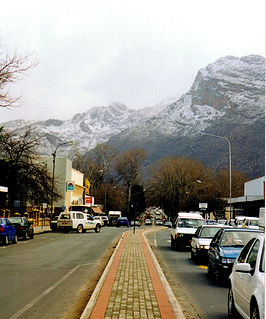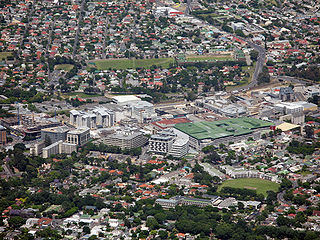
Witzenberg Municipality is a local municipality located within the Cape Winelands District Municipality, in the Western Cape province of South Africa. As of 2011 it had a population of 115,946.

Sir Herbert Baker was an English architect remembered as the dominant force in South African architecture for two decades, and a major designer of some of New Delhi's most notable government structures. He was born and died at Owletts in Cobham, Kent.

Worcester is a town in the Western Cape, South Africa. It is located 120 kilometres (75 mi) north-east of Cape Town on the N1 highway north to Johannesburg.
The following lists events that happened during 1929 in South Africa.

Heidelberg is a town in the Western Cape, South Africa. It is located near South Africa's south coast, on the N2 highway, 274 km east of Cape Town. Heidelberg is just east of the Overberg region, and some consider it the beginning of the Garden Route. Heidelberg is part of the Hessequa Local Municipality. Fourie House on Fourie Street is the oldest house in Heidelberg.

Ceres is the administrative centre and largest town of the Witzenberg Local Municipality in the Western Cape Province of South Africa. Ceres serves as a regional centre for the surrounding towns of Wolseley, Tulbagh, Op-die-Berg and Prince Alfred Hamlet. It is situated in the Warmbokkeveld Valley about 170 km north-east of Cape Town. Ceres is located at the north-eastern entrance to Michell's Pass and was the old route north between Cape Town and Johannesburg, which was later replaced by the N1 highway, which traverses the Breede River Valley to the south.

Claremont is a suburb of Cape Town, South Africa. It is situated six miles south of the city, and is one of the so-called "Southern Suburbs", it is situated alongside Lansdowne. It is an important commercial and residential area, which is currently experiencing significant growth and development.

Tulbagh, named after Dutch Cape Colony Governor Ryk Tulbagh, is a town located in the "Land van Waveren" mountain basin, in the Winelands of the Western Cape, South Africa. The basin is fringed on three sides by mountains, and is drained by the Klein Berg river and its tributaries. The nearest towns are Ons Rust and Gouda beyond the Nuwekloof Pass, Wolseley some 15 kilometres (9.3 mi) to the south inside the basin, and Ceres and Prince Alfred Hamlet beyond Michell's Pass in the Warm Bokkeveld.
Boegoeberg Dam is a gravity type dam on the Orange River, near Prieska, Northern Cape, South Africa. Building was started in 1926 and completed by 1933. Boegoeberg is named for the small tree Croton gratissimus, also known as Bergboegoe. Its primary purpose is for irrigation and it has a low hazard potential.

St. Peters United Evangelical Lutheran Church is a former Lutheran Church located in rural Clayton County, Iowa, United States. The church was a part of a village by the name of Ceres. The church building was listed on the National Register of Historic Places in 1976. The property is also known as the Pioneer Rock Church.

Jansenville is a town in Sarah Baartman District Municipality in the Eastern Cape province of South Africa.

Michell's Pass is a mountain pass in the Western Cape province of South Africa which approaches the town of Ceres from the south-west, connecting it to Tulbagh, Worcester and the Breede River Valley. The pass is traversed by the R46 road and the Ceres branch line railway, which was re-opened for use by the Ceres Rail Company and seasonally by Transnet Freight Rail in terms of an agreement between the Ceres Rail Company and Transnet in 2012. From its western entrance near Wolseley the pass ascends 190 metres (620 ft) to the summit at an elevation of 490 metres (1,610 ft), before descending a short distance into Ceres.

The Ceres Transport Riders' Museum, more commonly known by its Afrikaans name Ceres Togryers Museum, was started during the 1970s by members of the community of Ceres, South Africa who were interested in preserving the heritage of the town. It was proclaimed a local museum on 7 November 1978 and established as a province-aided museum with effect from 1 April 1987. The Board of Trustees is the governing body of the museum with powers vested in it by the Government of the Western Cape Province under the terms of the Cape Museum Ordinance and is responsible for the institution, its policies, its operational continuity and well-being, and the assets which it holds in trust for the people of Ceres, to whom it is ultimately accountable. The building in which the museum is housed was built as a flour mill during the early 1930s. The structure of the building was changed somewhat to accommodate the design by well-known Cape Town heritage architect Gawie Fagan.

In South Africa, as elsewhere in the world, the railways played a huge part in development and growth on nearly all terrains in the country. Conversely, events in South Africa and its neighbours over the years had a huge influence on the development of railways.

The Groote Kerk is a Dutch Reformed church in Cape Town, South Africa. The church is South Africa's oldest place of Christian worship, built by Herman Schuette in 1841. The first church on this land was built in 1678. Willem Adriaan van der Stel laid the cornerstone for the church. It was replaced by the present building in 1841, but the original tower was retained. The pulpit is the work of Anton Anreith and the carpenter Jacob Graaff, and was inaugurated on 29 November 1789. The Groote Kerk lays claim to housing South Africa's largest organ, which was installed in 1954 and has 5917 pipes.

Cathedral of St Mark in George in South Africa is the seat of the Diocese of George of the Anglican Church of Southern Africa. The present bishop is Brian Melvin Marajh.
The Keetmanshoop Reformed Church is a congregation of the Reformed Churches in South Africa (GKSA) in southern Namibia, headquartered in the town of Keetmanshoop but also embracing members from the towns of Aroab, Aus, Bethanie, Koës, Lüderitz, and Rosh Pinah. Since the congregation is paired with the Mariental Reformed Church, where the Rev. Johan Dunn is the current pastor since 2017, it also serves members from Mariental, Kalkrand, Maltahöhe, Stampriet, and Gochas. The collective Keetmanshoop-Mariental area is enormous, almost the size of the United Kingdom. The distance between Lüderitz and Stampriet is 500 km, and the even the distance between the two congregational seats, Keetmanshoop and Mariental, is 230 km.

The 1969 Tulbagh earthquake occurred at 20:03:33 UTC on 29 September. It had a magnitude of 6.3 and a maximum felt intensity of VIII (Severe) on the Modified Mercalli intensity scale. It caused widespread damage in the towns of Ceres, Tulbagh and Wolseley and led to 12 deaths. The earthquake was a result of strike-slip faulting along a NW-SE trending near vertical fault plane, as shown by the focal mechanism and the distribution of aftershocks.
The Johannesburg East Reformed Church was a congregation of the Dutch Reformed Church in South Africa (NGK) in the Johannesburg suburb of Doornfontein, just east of downtown. It is also known as the Irene Church after the sobriquet of its second and third churches on 1 Beit Street. Five weeks before its centennial, on June 1, 1997, Johannesburg East was absorbed by the Johannesburg Reformed Church (NGK), from whence it had seceded on July 8, 1897.
The Potchefstroom Reformed Church (in Potchefstroom, North West, South Africa, is the oldest congregation of the Dutch Reformed Church in South Africa in what was then the Transvaal or South African Republic. At its founding in March 1842, it was the 28th congregation in what would later become South Africa and the tenth outside of the Western and Southern Cape Synod.

















